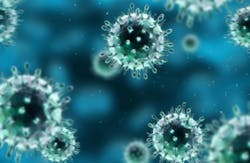What are they:
- Viruses consist of RNA or DNA wrapped in a protein coat. They are considered to be quasi-living organisms. They are parasitic at the cellular level.
- Viruses are submicroscopic particles that infect cells. They enter a cell and take over the DNA function so that it replicates the virus, then multiple copies of the virus are released from the cell from leakage or rupture.
- Viruses are very small but their molecular weights are very large. For example, the molecular weight of a poliovirus is about 2,600,000 daltons and adenovirus is about 157 million daltons. By comparison, the molecular weight of chloroform is only about 120 daltons (dalton is the molecular weight unit that was once grams/mole).
- Probably all organisms, even bacteria and plants, have viruses for which they are a host. Viruses are selective and hosts are susceptible only to specific viruses.
- Bacterial viruses are called phages, e.g. coliphages infect coli bacteria.
- Numerous viruses are present in air, food, water, surfaces and adsorbed to some particulates.
- They are fairly stable in the environment, but they are denatured by oxygen, sunlight, heat and disinfectants like chlorine and ozone.
- Viruses are very different from bacteria. They are much smaller, do not have cell walls and are not free living.
- Viruses are nanometer-sized and 10 to 100 times smaller than bacteria, which are usually in the one or two micron size range. They are observed by electron microscopy.
- Some antiviral medications are available; antibiotics are not effective against viruses.
- The shapes of viruses are very distinctive.
Health effects:
- Some viruses that infect humans include influenza viruses, rhinovirus (common cold), hepatitis, polio and norovirus.
- Some think that even one virus particle may be sufficient to initiate an infection.
- Viral gastroenteritis is a general term for illnesses that involve inflammation of the stomach or intestines.
- Viruses that cause gastroenteritis include: Rotavirus, norovirus and adenovirus, and these can be in contaminated water.
- Gastroenteritis symptoms usually include: Diarrhea, cramps, vomiting and fever. They usually clear in one or two days.
- Some virus infections are much more serious. For example: Hepatitis A; some viruses can be carcinogenic, e.g. hepatitis B and C.
- There were 33 reported drinking water related disease outbreaks in 2010. Two were virus: Norovirus and hepatitis A. This is certainly under-reported and fewer than many prior years.
Water treatment:
- Conventional drinking water treatment (coagulation, flocculation, sedimentation, filtration, disinfection) is effective for virus removal.
- Chlorine, hypochlorite, chlorine dioxide and ozone are all excellent primary disinfectants and most effective when applied to clarified low turbidity water.
- Chlorine and hypochlorite are very effective against bacteria and viruses, but not protozoa.
- Disinfectant efficacies are quantified by the product of concentration (C) in mg/l and time (T) in minutes (CT value, except for UV) required to achieve the desired logs of disinfection under the pH and temperature conditions. The lower the CT the better. Chloramine is considerably less potent than the others.
- Examples for single strand virus inactivation CTs are provided below:
|
Disinfectant |
CT Log Inactivation at 10o C |
||
|
|
2-log |
3-log |
4-log |
|
Chlorine1 |
3 |
4 |
6 |
|
Chloramine2 |
643 |
1067 |
1491 |
|
Chlorine dioxide3 |
4.2 |
12.8 |
25.1 |
|
Ozone |
0.5 |
0.8 |
1 |
|
UV (mWs/cm2) |
21 |
36 |
NA |
Source: EPA 815-R-99-01 1. pH range six to nine, chlorine residual 0.2 to 0.5 mg/l.; 2. pH eight; 3. pH range six to nine.
- RO membranes remove virus by size exclusion. Even microfiltration and ultrafiltration membranes are often effective for multilog removals although their pore sizes are larger than many viruses. This may be due to viruses bound to particulates and fouling that reduces the effective pore size.
- Limited removal credit is often given by regulators for even RO because of concerns about potential membrane leakage.
Analyses:
- Testing for human viruses in drinking water is not routinely done, except when a waterborne outbreak has occurred.
- PCR (polymerase chain reaction) techniques can identify DNA from specific viruses, but they do not determine whether the virus particle/fragment was intact and infectious.
- Testing for coliphage indicator organisms is readily available. Detection of viable coliphage indicates that the water was likely of sewage origin and that the treatment process was not effective at removing the coliphage and, therefore, was probably not effective for eliminating pathogenic viruses and bacteria that might have been present in the water.
- In general, treatment adequacy is determined by the presence of a disinfectant residual and contact time to achieve sufficient kill of the pathogens, i.e. sufficient CT value for the conditions.
Regulation:
- Surface water treatment regulations require at least four logs of removal of viruses.
- Groundwater treatment regulations require four logs of virus removal for systems that require treatment.
- Non-public water supplies are not nationally regulated, but private wells are often at risk from septic tank and surface percolation.


